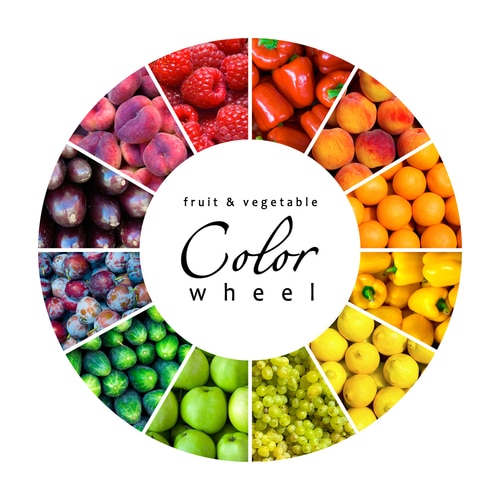 Experts recommend you fill your plate with an array of colorful vegetables and fruits to maximize the health benefits of your diet – and for good reason. Veggies and fruits get their color from plant pigments that help to protect plants against predators. These same pigments protect human cells against damage and have a variety of other health benefits that make them worthy candidates for your dinner plate. Have you ever wondered what these colors can do for you? Here’s a rundown on what each color means for your health.
Experts recommend you fill your plate with an array of colorful vegetables and fruits to maximize the health benefits of your diet – and for good reason. Veggies and fruits get their color from plant pigments that help to protect plants against predators. These same pigments protect human cells against damage and have a variety of other health benefits that make them worthy candidates for your dinner plate. Have you ever wondered what these colors can do for you? Here’s a rundown on what each color means for your health.
Red Vegetables and Fruits
Some red vegetables like tomatoes contain a type of carotenoid called lycopene. Lycopene is an antioxidant that helps to reduce inflammation, especially the type that’s linked to heart disease. Some research suggests lycopene-rich foods lower the risk of heart disease and some types of cancer, especially prostate cancer. Tomatoes are a good source of lycopene, but the body is best able to use lycopene when tomatoes are heated or processed. Think spaghetti sauce and tomato sauce over cold tomatoes.
What to Put on Your Plate: tomatoes, tomato sauce, pink grapefruit, watermelon, apricots, and guava
Dark Red/Purple Vegetables and Fruits
Dark red and purple fruits and vegetables like strawberries, raspberries, red cabbage, and cranberries contain reddish-purple pigments called anthocyanins. Like lycopenes, anthocyanins are antioxidants and reduce inflammation. They may lower the risk of some types of cancer and are particularly important for brain and eye health. Preliminary research suggests that anthocyanins in fruits and vegetables may ward off some degenerative brain diseases associated with aging as well as age-related memory loss. Dark red and purple fruits and veggies are good brain food and memory boosters.
What to Put on Your Plate: watermelon, pink grapefruit, tomatoes, cranberries, cherries, strawberries, blueberries, black raspberries, blackberries, raspberries, red cabbage, purple broccoli, beets, eggplant, acai berries, red wine
Orange Fruits and Veggies
Orange fruits and vegetables such as carrots and sweet potatoes contain carotenoids called alpha and beta-carotene. Beta-carotene is an antioxidant that’s important for a healthy immune system and good vision. Some beta-carotene is converted to another antioxidant vitamin – vitamin A. Alpha and beta-carotene are also important for normal cell growth and communication between and may keep abnormal cell growth in check, thereby reducing the risk of some types of cancer.
What to Put on Your Plate: sweet potatoes, squash, cantaloupe, pumpkin, carrots, mango
Green Veggies
Many green vegetables, especially cruciferous ones, contain powerful anti-cancer chemicals including sulforaphanes and indoles that help the liver detoxify and break down cancer-causing chemicals. These powerful chemicals also help to regulate estrogen levels in women. Green, leafy vegetables are a rich source of vitamin K, a vitamin that’s important for normal blood clotting and one that may reduce the risk of osteoporosis and heart disease. Some green vegetables also contain carotenoids like lutein that are important for healthy vision and may protect against macular degeneration and cataracts, two common causes of visual loss.
What to Put on Your Plate: Swiss chard, spinach, kale, cabbage, broccoli, collard greens, turnips greens, watercress, and bok choy.
Yellow/Orange Fruits and Vegetables
Yellow fruits and vegetables like summer squash, grapefruit and oranges are rich in vitamin C, a strong antioxidant that’s important for healthy joints and skin and a healthy immune system. Yellow citrus fruits contain compounds called limonoids that may protect against some types of cancer. The peel and pulp of oranges contain a flavonoid called hesperidin that lowers blood pressure naturally. It’s used in Europe to treat varicose veins and hemorrhoids.
What to Put on Your Plate: oranges, lemons, grapefruit, yellow squash, spaghetti squash
The Bottom Line?
A plate of fruits and veggies in all the colors of the rainbow is good protection against disease and helps to slow down the aging process. Enjoy these colorful vegetables and fruits in abundance.
References:
Mol Nutr Food Res. 2007 Jun;51(6):675-83.
Nutrition 2000 Jul-2000 Aug 31;16(7-8):577-8 2000. PMID:15140.
Nutraingredients.com. “Carotenoids Play Role in Cell Communication”
Weekly Health Update. “Hesperidin in Orange Juice Improves Hypertension and Arterial Function”
Related Articles By Cathe:
The Nutrient-Packed Power of Purple Vegetables and Fruits
Beyond the Rainbow: 6 Black Superfoods to Supercharge Your Diet
Purple Foods: Health Benefits of the Color Purple
Can Compounds Found Naturally in Plants Boost Brain Function?
6 Ways to Get More Health and Nutritional Benefits from Fruits and Vegetables
What Are the Most Nutrient-Dense Fruits and Vegetables? You Might Be Surprised

